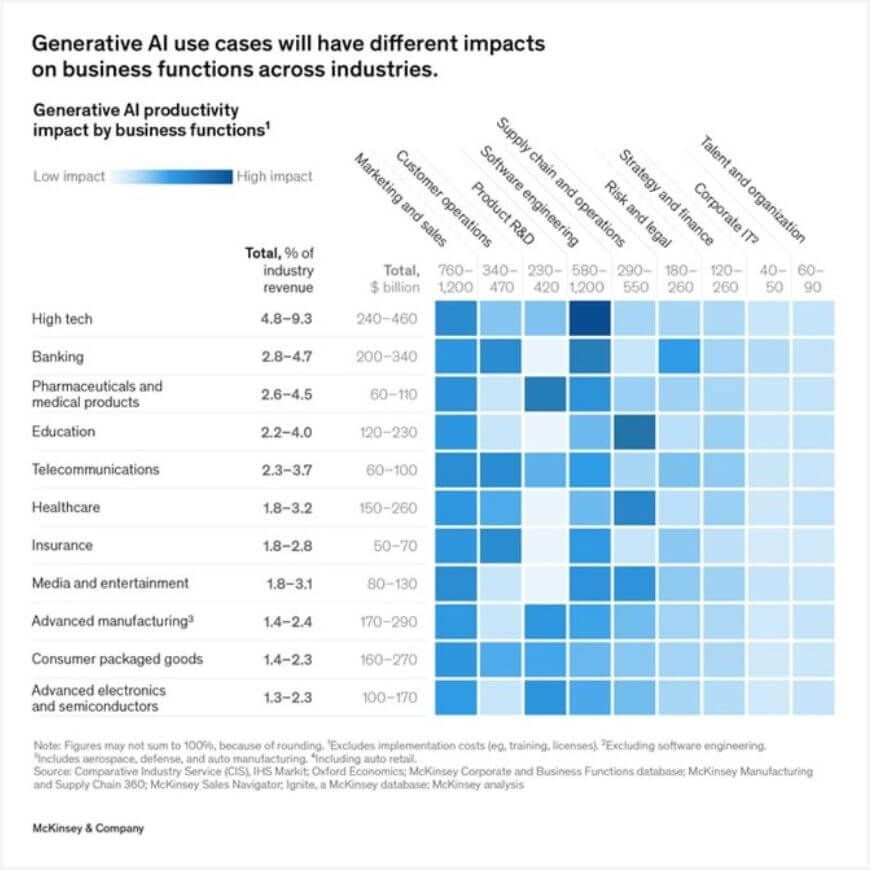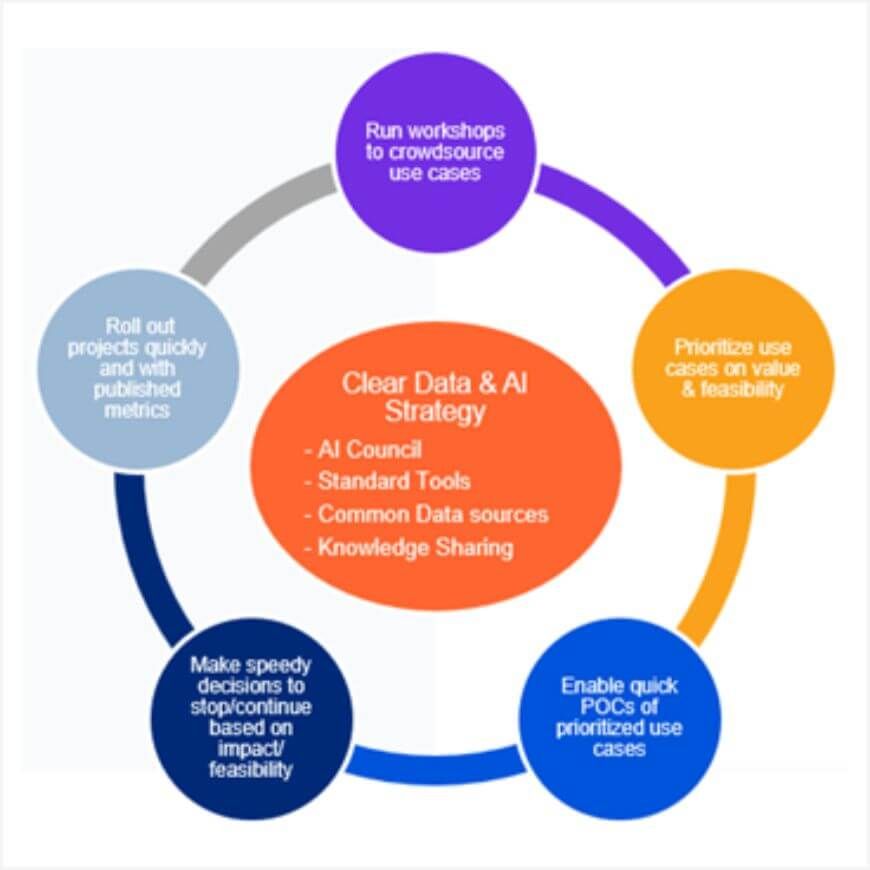In today’s rapidly evolving technological landscape, the adoption of Artificial Intelligence (AI) is no longer a luxury but a necessity for companies aiming to stay competitive. This blog explores the critical importance of having a well-defined AI adoption strategy. It delves into popular strategies that companies are employing to integrate AI into their operations and provides practical tips for creating an effective AI adoption plan. By understanding and implementing these strategies, businesses can harness the full potential of AI to drive innovation, efficiency, and growth.
Introduction
Artificial intelligence has always been a critical part of our product offerings at PROS. Since the company was founded in 1985, our mission has been to help people and companies outperform by enabling smarter selling in the digital economy, and we have leveraged AI capabilities heavily to achieve this goal. We started with overbooking algorithms that predict the likelihood of airline customers to show up and adjusting airlines’ inventories to reflect this behavior. We expanded into revenue management optimization and continued to grow in the pricing space. Almost four decades later, we are at the forefront of AI applications inside of our products.
More recently, as Generative AI capabilities became mainstream at the end of 2022, we are starting to see more and more applications of AI across the organization with the boundaries of product-specific applications blurring rapidly. In this context, it has become critical for every single part of our (and your) organization to take advantage of these capabilities to not only stay competitive, but also surpass your competition.
McKinsey estimated the impact of generative AI on various business functions across numerous industries, as shown in the chart below, and highlighted its immense potential value.

Figure 1: Impact of GenAI across industries and business functions
Successfully leveraging AI in the era of Generative AI requires a well-defined adoption strategy. In this article, we delve into the need for and importance of an adoption strategy, why it is key, what its uses and value are, and how it should evolve and impact your internal adoption of AI.
Why having an AI adoption strategy is key
AI, and Generative AI in particular, are capabilities that are not trivial to use effectively. Historically, AI capabilities have been under the purview of very specific teams in your organization, such as your data science team or your advanced analytics team. As Generative AI tools started to become more and more available, so did the “democratization” of AI offerings and solutions – today, anyone can access and use ChatGPT or Microsoft Copilot without even the need for an account with either company. As such, AI tools have shifted into the hands of all your users and given them access to extraordinary capabilities. And, as the saying goes, “with great power comes great responsibility”. It is the responsibility of the organization to make sure that this great power is used appropriately, and this is where AI adoption is critical.
Having an adoption strategy will help everyone in your organization along three key dimensions:
- Enhance operational efficiency and productivity
The promise of Generative AI – and AI in general – is to become more productive and automate some of the repetitive tasks that your users complete daily, giving them more time to focus on other aspects of their work. - Drive innovation and create new business opportunities
AI gives us the ability to analyze vast amounts of data, thereby identifying emerging trends and customer needs, and ultimately leading to new opportunities and innovative solutions. - Mitigate the risks associated with AI implementation
This last point is perhaps the most important aspect of your AI adoption strategy. AI comes with a certain number of risks, ranging from ethical risks to the more mundane risk of having a proliferation of tools attempting to solve the same problem within your organization.
Let’s review some of the typical adoption strategies that can be used for AI adoption and dig deeper into how we have approached the problem at PROS.
Two AI Adoption Strategies
There are essentially two typical approaches to AI adoption – or adoption of new technologies and solutions in general.
The first approach is an “incremental approach” whereby you identify a set of use cases and pilots to run tests on. You then incrementally build on your learnings to roll out more and more offerings. This is the approach that we have chosen to follow for our internal applications at PROS (our productized solutions follow a different methodology building on years of experience).
The second approach is a more global transformation or “full-scale transformation”. As the name suggests, this approach implies a full transformation of the company to take on AI at scale. As McKinsey, such a strategy requires very strong engagement from the C-suite, a well-defined data strategy along with a talent management focus.
In both cases, there are common requirements that can make or break both strategies.
- Centralized oversight committee – having a team with global visibility into the transformation efforts is key under both approaches. By definition, such a team should be included in a “full-scale” global transformation. It should also be part of the incremental approach, if for no other reason than to ensure consistency of the work across all teams running proof of concept tests. The role of the committee is threefold: (1) maintain visibility into AI use cases across the company and raise awareness, (2) cross-pollinate and ensure that information is flowing across the various teams that are testing AI solutions. Why reinvent the wheel if another team has already figured out the solution to your problem? And, last but not least, (3) ensure ethical applications of your AI solutions.
- Cohesive data strategy – We all know the phrase “garbage in, garbage out”: having a well-defined and cohesive data strategy will ensure the quality and consistency of AI solutions. Data continues to be an increasingly important part of any product and solution, and having clean data in a common, easily accessible location is of utmost importance to AI adoption.
- Budgeting strategy – Ensuring that your teams are committed to the adoption and deployment of AI strategies requires some degree of financial commitment – whether through people’s time allocated to testing, or through the investment in AI tools and solutions (internally or externally).
At PROS, we have embarked on this journey by implementing the incremental approach for our internal AI applications. We are focusing on enhancing, upgrading, and turbocharging some of our core business processes, with an eye towards transformative applications. In his opening keynote (paywall protected) at the TSIA Envision conference (October 2024, Las Vegas), TSIA President and CEO J.B Wood shared his vision of the future of AI and highlighted the fact that some of the highest value from AI lies in its transformative power beyond the initial upgrades to existing processes.
Our tips for facilitating AI adoption
We already discussed some of the key components on how to ensure a successful AI adoption strategy, namely an oversight committee, a cohesive data strategy and a budgeting strategy. In addition to these key components of a successful adoption process, we also devised a framework to identify key AI use cases and deploy them quickly, as shown in Figure 2.

Figure 2: PROS Framework for AI use case deployment
This framework has five steps: In the first step, we run workshops to crowdsource use case ideas. We then evaluate and prioritize use cases along the two key dimensions of complexity and ROI. We then deploy the top use cases and re-evaluate our original estimates of complexity and ROI using KPIs specifically designed for each of these use cases. We then iterate on this process.
This framework has proven quite successful and allowed us to deploy numerous use cases with great success, of which I will share a few examples.
- On the simpler side, and yet very satisfying in its simplicity, we leveraged generative AI’s ability to “understand” pictures and screenshots to automate the user acceptance testing process in our deployments. We can now “show” generative AI tools a picture of the solution and ask it to propose acceptance test cases for users to iterate upon. These test cases are not perfect, but they allow users to get started and avoid the infamous writer’s block by providing a very high-quality starting point.
- At the other end of the spectrum, our teams created a data interpreter that can automate the process of mapping ERP data fields to our required data fields. The complexity of ERP data fields and the lack of intuitive naming or consistency across deployments can make it highly time consuming for our customers to generate these mappings. Generative AI has proven extremely apt at automating this process leading to huge time savings.
In both use cases, a thorough human review continues to be critical to validate the accuracy of the AI-generated solution.
In summary, to facilitate adoption, we recommend four key components: an oversight committee (we call it the AI Council), a cohesive data strategy, a budgeting focus, and an adoption framework.
Conclusion
We have discussed the immense value that AI can bring to the world as a whole and to individual businesses in particular. In yet another study, McKinsey discusses the profound impact that AI will have on B2B sales: it will change how salespeople interact with their customers, potentially deferring initial interactions to AI chatbots, only to take over later in the sales process. It will unlock growth by opportunities by identifying segments and markets that may have been underserved. It will help allocate resources more efficiently leading to higher win rates and shorter sales cycles. The possibilities seem limitless.
Despite all of this, the value of AI continues to be challenging to find. BCG shares a study where they find that only 22% of companies have advanced beyond the proof of concept stage to create some value, and only 4% are creating substantial value. In a similar analysis, an MIT survey finds that 76% of companies have only deployed AI in one to three use cases. However, the consensus they all share is AI leaders drive 1.5 times higher revenue growth, 1.6 times greater shareholder returns, and 1.4 times higher returns on invested capital (BCG, McKinsey)
In this environment, it is critical to ensure that you have a strategy to successfully adopt AI inside your company. We shared our views on how to successfully accomplish this goal by setting up the right capabilities and expectations inside your organization and following a well-defined framework to evaluate and deploy use cases.
Frequently Asked Questions
An AI adoption strategy ensures businesses can leverage AI effectively to enhance productivity, drive innovation, and mitigate risks.
The two strategies are incremental adoption, focusing on pilot use cases, and full-scale transformation, requiring strong C-suite engagement and a cohesive data strategy.
AI automates repetitive tasks, allowing employees to focus on higher-value activities and improving overall productivity.
Risks include ethical concerns, tool proliferation, and inconsistent implementation, which can be mitigated with a centralized oversight committee.
The PROS framework involves crowdsourcing use cases, prioritizing by complexity and ROI, deploying top use cases, and iterating based on KPIs.
Key components include a cohesive data strategy, a dedicated oversight committee, a clear budgeting focus, and a structured adoption framework.
Generative AI enables data analysis, trend identification, and innovative solutions, creating new business opportunities and enhancing customer experiences.